Large-eyed figures carved into a stone block, on the remote Pacific island of Nuku Hiva, possibly depicting deities or ancestors. Marquesas Islands, French Polynesia, 11th century AD
Highest point – mount Tekao (1224 m). Nuku Hiva resembles a quadrangle in shape, the length of which is 30 km, and the width is 15 km. The administrative center of the Marquesas Islands, the city of Taioahae ( Taiohae), is located on the southern coast of the island near the bay of the same name.
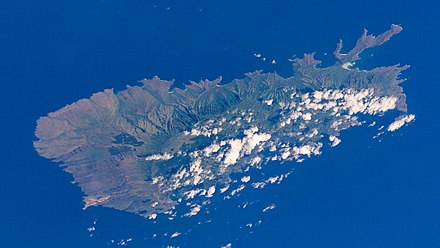
Space shot of the island
History
The main archaeological work on the island was carried out in the 1960s by an American expedition near the settlements of Waa ( Uaa) and Taipivai… As a result, it was established that the first people sailed to the island in 150 AD. e. One of the main occupations of the locals at that time was pottery, which was also practiced on the islands of Samoa and Tonga. The period of development on Nuku-Khiva lasted until 1100 AD. e. During this time, residents were able to fine-tune the stone processing technique that was used in the construction of housing. A large number of stone structures was built on the island between 1400 AD. e. , including famous sculptures tics.
The first Westerner, the American explorer Joseph Ingram, landed on Nuku Khiva in April 1791. Subsequently, many other ships sailed to the island, replenishing their ship supplies to Nuku-Khiva. The first European to land on the island was the Frenchman Etienne Marchand (July 1791). In 1804, a Russian traveler, Admiral Ivan Fedorovich Kruzenshtern, visited Nuku Khiva. In 1826, when landing on the island from the Russian expedition sloop “Krotkiy”, the local population killed and eaten midshipman A. L. von Deibner and two unknown sailors.
The island, its indigenous population and their customs were described in his work “Typi” (Turey) by Herman Melville, who escaped from a whaling ship and lived on the island.
Subsequently, many sandalwood traders, whalers and adventurers sailed to the island. In 1813, the Americans, namely David Porter, tried to annex Nuku Hiva, but the attempt failed. In 1839, the first Catholic missionaries appeared on the island, and in 1842 Nuku Hiva was annexed by France, whose authorities immediately built a fort in Taiohae Bay. The Christianization of the inhabitants took place with great difficulties, since local tribes constantly fought on Nuku-Khiva. In 1854, the first Catholic cathedral was laid in Taiohae. The Europeans who appeared on the island brought many diseases to Nuku Khiva, against which the locals had no immunity. In 1863, a smallpox epidemic broke out on the island, which killed more than 1,000 people. Part of the island’s population during this period was taken away by Peruvian slave traders; in 1883, opium was imported by the Chinese. As a result, by 1934 the population of Nuku Khiva was only 635 people, compared to about 12 thousand in 1842. At the beginning of the 20th century, Czech settlers appeared on the island, who soon moved to the island of Tahiti.
Administrative division
The islands of Nuku Hiva, Motu Iti, Motu One, Hatutu and Eiao form the Nuku Hiva commune, which is part of the administrative division of the Marquesas Islands.
Island or reefLand area,
km²Lagoon area,
km²Population,
people (2007)Administrative centerNuku Hiva387-2660HatiheuMotu Ichi0,2—Motu-One1— 6,4—Eiao43,8—Nuku Hiva commune438,4-2660
In many places on our planet, archaeologists find unusual artifacts that do not reveal the mysteries of history, but only increase their number. One such artifact is outlandish statues of Nuku Hiva islandthat have no analogues on Earth.
Looking at them, one involuntarily ponders what kind of wild fantasy these mysterious creatures could create. Or maybe alien reptilians who once visited the island served as models for the ancient sculptures?
The quadrangular island of Nuku Hiva (formerly called Madison) is an atoll with an area of \u200b\u200b330 square kilometers, its length is 30 kilometers, and its width is 15 kilometers. It is the largest island in the Marquesas archipelago of French Polynesia.
Nuku Hiva means “The Majestic Island” in translation, and this is quite justified. The nature here is incredibly beautiful. Lush greenery adjoins mountain heights, in the warm ocean waters, a diverse, colorful underwater world shakes the imagination of even the most sophisticated traveler.
This natural picture is complemented by two extinct volcanoes surrounded by pointed rocks. The crater of one of them was filled with water, such a few places can be seen. Plus, the absence of any natural disasters and rainy seasons. Directly heaven on earth. We can say that Nuku-Hiva is a sparsely populated island. A little more than 2 thousand inhabitants live here permanently.
FROM THE DEPTH OF AGES
 In the middle of the last century, American archaeologists carried out excavations on the island. Based on them, it was established that the first inhabitants appeared here as early as 150 AD. e. They came from the island of Samoa, then they gradually colonized New Zealand, the Cook Islands, Tahiti and Hawaii.
In the middle of the last century, American archaeologists carried out excavations on the island. Based on them, it was established that the first inhabitants appeared here as early as 150 AD. e. They came from the island of Samoa, then they gradually colonized New Zealand, the Cook Islands, Tahiti and Hawaii.
The population was mainly engaged in pottery and stone processing. That is why stone houses, famous tiki sculptures and other structures were already on the island in 1100.
As the centuries passed, the island’s population grew at a tremendous rate. By the time the first Europeans appeared on Nuku Hiva, about 100 thousand inhabitants lived on this small piece of land among the ocean. During the existence of Nuku-Hiva, there were attempts to seize the island by the Americans, but they were unsuccessful.
In 1842, the island became part of France, at the same time the construction of a Catholic cathedral began. But, even despite the constant visits of missionaries, Christianity took root here with difficulty. In addition, the island’s population was gradually decreasing. Tribal wars claimed many lives. In addition, the Europeans brought here diseases to which the natives did not have immunity.
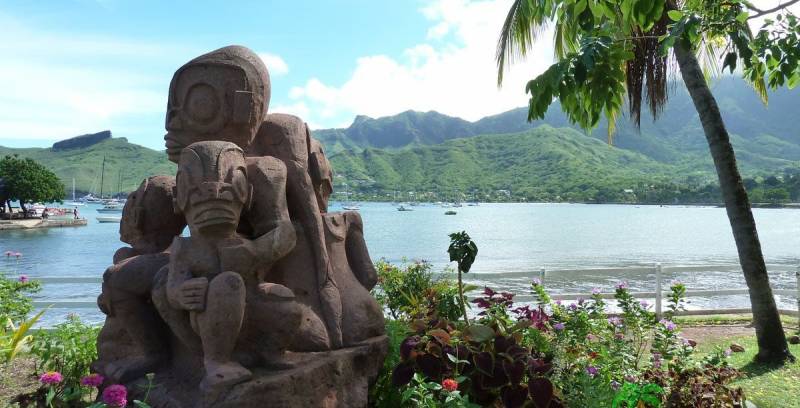
So, in 1863, as a result of the smallpox epidemic, about 1,000 people died. Peruvian slave traders replenished the stocks of slaves here, and in 1883 the opium imported by the Chinese finally “solved” the demographic problem. And in 1934 only about 600 people remained on the island.
Like any other people, the local population has a legend about the origin of Nuku Hiva. According to her, the god Ono boasted to his wife that he would build a house in just one day. To do this, he gathered all the earth, from it he created islands, each of which corresponded to a certain part of the house. Nuku Hiva was a roof in this structure. The rest of the land Ono collected in a heap – thus the island of Wa-Huka, located now east of Nuku-Hiva, was created.
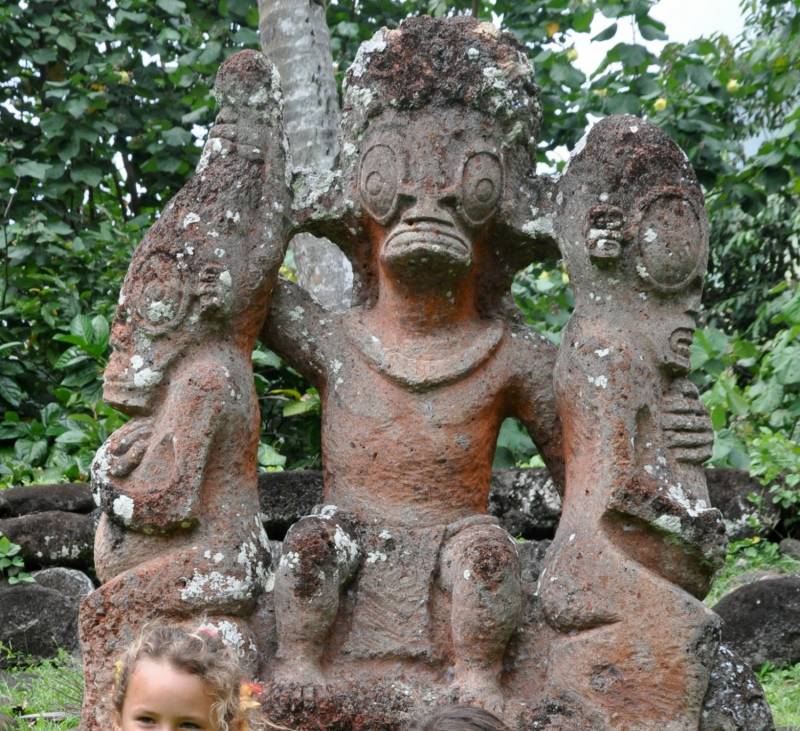
GOURMETS NUKU-KHIVA
Since such a small piece of land was densely populated, the problem of food was perhaps the most important. Basically, the aborigines ate plant foods: breadfruit, bananas, cassava, etc. It is clear that protein was always in short supply. Even the fish that could be caught in the ocean waters were not enough to feed so many mouths. Not to mention pigs and chickens, even dogs were not disdained here.
Perhaps that is why, according to scientists, many local tribes practiced cannibalism. More often for replenishing protein in the diet than for ritual ceremonies. But the latter, too, cannot be discounted. The inhabitants of the island appeased the sea deity Ica, bringing him human sacrifices.
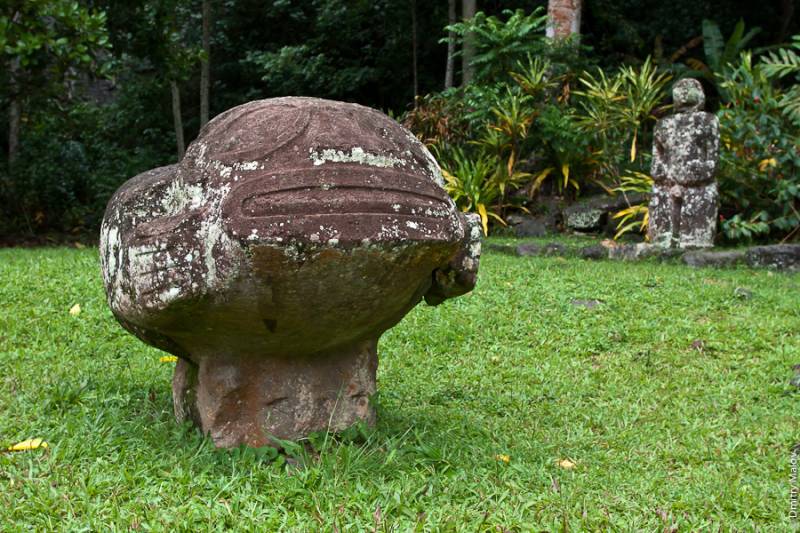
The unfortunate man, like a fish, was caught on a hook, and then tied and hung on a tree above the altar. For some time, the victim was not touched, and then they began to beat him on the head with a truncheon until the brains were blown out.
And some scientists believe that eating their own kind was necessary only for women and children.
for food. The men of the tribe thus appropriated the power of a defeated enemy. For the same purpose, they collected the skulls of the people they ate.
Aliens
It would seem that there is nothing special in Nuku Hiva: beautiful nature, exotic local customs – everything is like in other Polynesian islands. Only on this island is the Temehea Tohua village, next to which there are several unique statues that have no analogues in the world.
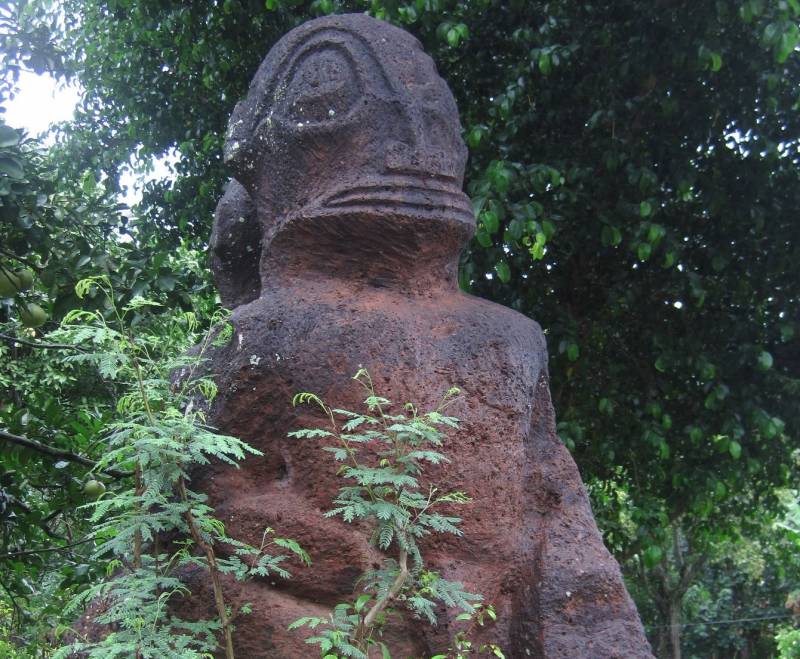
Presumably the sculptures are stone deities of the ancient Polynesians, dating back to the 11th-14th centuries. Actually, how many stone idols on Earth? Only tiki idols, as they are called, are special. They all have a strange appearance.
It seems that the ancient sculptors carved out of stone obviously not earthly inhabitants. The creatures immortalized in stone had bodies with bulging bellies, large oblong heads, on which huge eyes stood out.
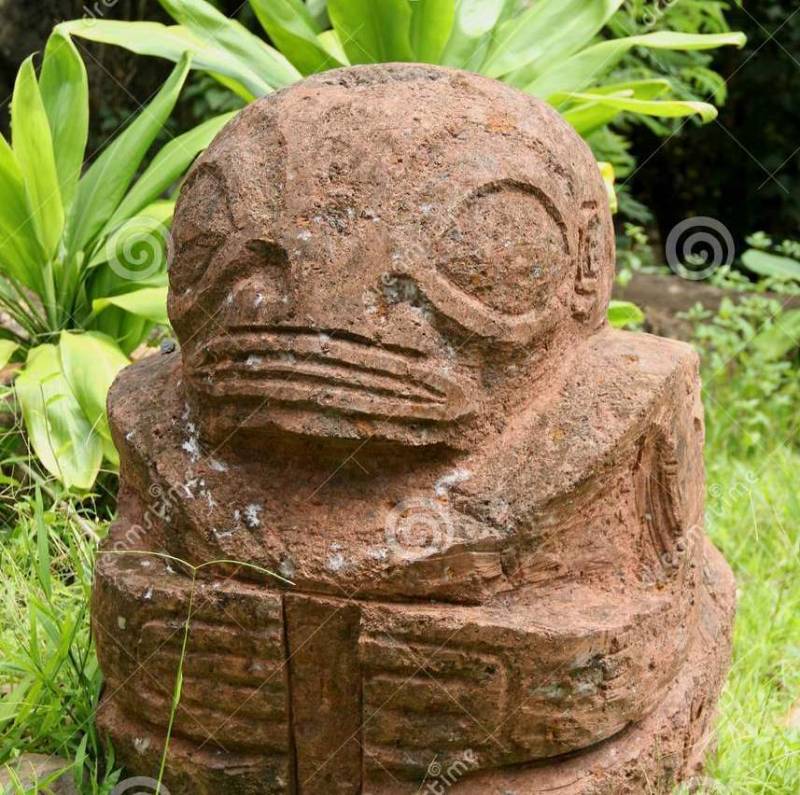
And they were dressed in clothes very similar to space suits. Scientists have not yet been able to find out what it is: the fruit of the fantasy of an insane sculptor or the impression of a meeting with alien beings. But even the most skeptical researchers believe that there is nothing human about these statues.
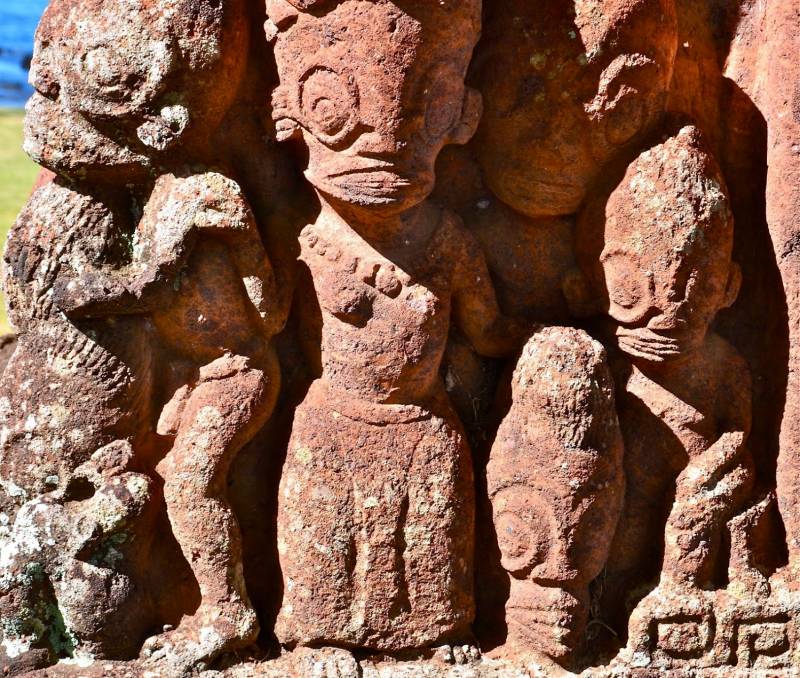
Meanwhile, the tics are very reminiscent of the descriptions of guests from distant space, with whom our contemporaries met. It turns out that the residents of Nuku-Khiva saw them too? And they did not just see, but fell under their power, if they worshiped them as deities and worshiped them.
The largest statue is 2.5 meters high. No sculpture repeats another, each depicts a specific deity. Local residents are still convinced that tiki carries the power of the depicted god. One helps in military affairs, the second saves from trouble, the third contributes to a rich harvest, etc.
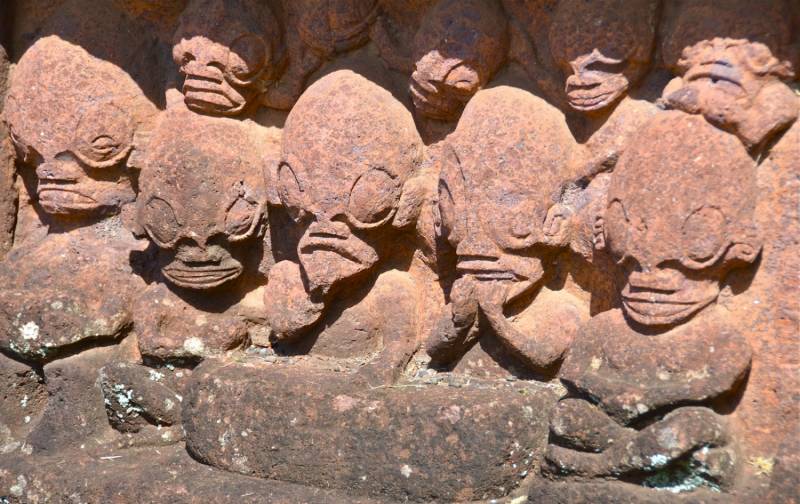
Those who adhere to the version of the aliens believe that different groups of aliens served as models for tiki. Some sculptures are like reptilians – the most ancient and evil, according to ufologists, creatures in the universe. By the way, their civilization has reached a high level of development, and its representatives could well manage people. This is the question of tiki worship.

Another group of sculptures, according to the same ufologists, depicts “gray aliens”. They vaguely resemble a man with a frail body, thin arms and a huge head. Only disproportionately large eyes and mouths betray alien beings in them.
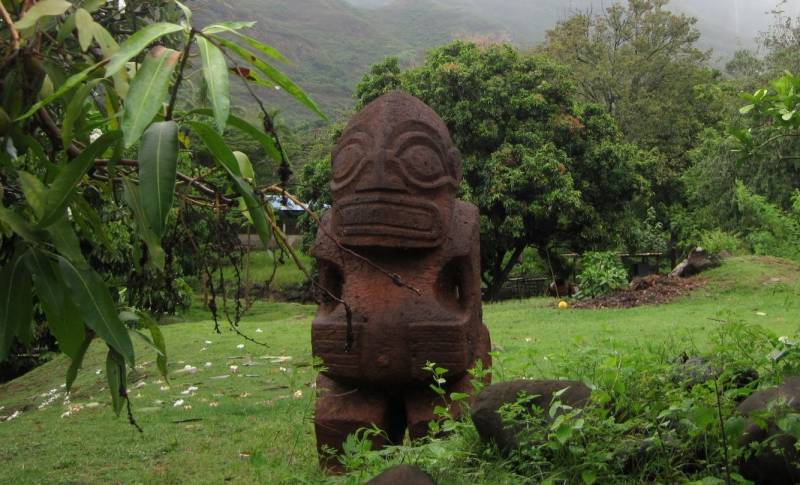
It is believed that reptilians first appeared on the island. They were able to enslave people, make them worship, become deities for them. And then they also created the “gray aliens”, using them as slaves. That is why the sculptures are so different from each other.
Related Post
A shocking documentary proves that mermaids do exist
SHOCKING Revelation: Thuya, Mother of Queen Tiye, Was the Grandmother of Akhenaten and Tutankhamun—What Ancient Egyptian Secrets Did She Leave Behind?
Breaking News: Astonishing Discoveries at Karahan Tepe Confirm an Extraterrestrial Civilization is Hiding on Earth, and NO ONE Knows!
Breaking News: Researchers FINALLY Discover U.S. Navy Flight 19 After 75 Years Lost in the Bermuda Triangle!
NASA’s Secret Investigation: Uncovering the Astonishing Mystery of the UFO Crash on the Mountain!
Explosive UFO Docs LEAKED: Startling Proof That Aliens Ruled Ancient Egypt!